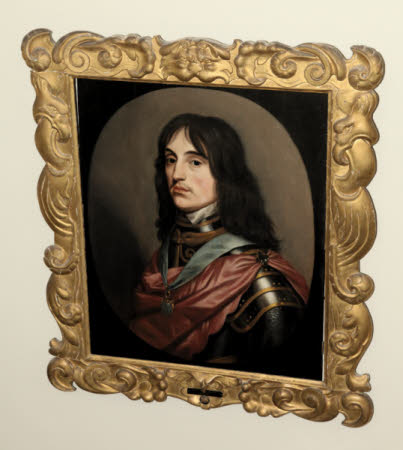Prince Rupert of the Rhine, Count Palatine, Duke of Cumberland (1619-1682)
Gerrit van Honthorst (Utrecht 1590 – Utrecht 1656)
Category
Art / Oil paintings
Date
1630 - 1656
Materials
Oil on panel
Measurements
743 x 591 mm (29 1/4 x 23 1/4 in)
Order this imageCollection
Ashdown House, Oxfordshire
NT 493057
Summary
Oil painting on panel, Prince Rupert of the Rhine, Count Palatine, Duke of Cumberland (1619-1682) by Gerrit van Honthorst (Utrecht 1590 – Utrecht 1656). A painted oval, head-and-shoulders portrait, turned to left, long black hair, wearing armour with carmine cloak clasped at his left shoulder and blue ribbon and, possibly, the Order of St Esprit. Prince Rupert was the third, but second surviving son of Frederick V and was brought up in exile in Holland. He first followed his elder brother, Charles Louis, to England in 1636, staying for about a year, earning golden opinions from Charles I, and returning to the Netherlands in July 1637. A year later, he took part with his brother in an invasion of Westphalia, only to be captured by the Imperial forces on 17th October 1638. For the next three years he was held captive at Linz. After his release had been negotiated by Sir Thomas Roe, he rejoined his mother at The Hague on 10th December 1641. In February 1642 he went to England again, to thank Charles I for obtaining his release, and escorted Henrietta Maria to Holland on his return. In April, he was made a Knight of the Garter, along with James, Duke of York. In July 1642 he landed at Tynemouth, to join Charles I at Nottingham, where the latter raised his standard and began the Civl War on 22 August. The greater detail of this preamble is designed to indicate when and how Rupert might have been painted by Honthorst. He inspired the Royalist forces with new vigour, and improved the tactics of their cavalry, but his strategic advice and decisions were less sound, and sometimes threw away the results of localised victories, as at the Battle of Edgehill (23rd October 1642. In 1644 he was created Duke of Cumberland and Earl of Holderness. Promoted General of the Horse to Charles I, and after a series of victories exiled, following defeat by the Parliamentary army at Oxford. Returned to England at the Restoration to receive high naval and military honours. Co-founder of the Hudson Bay company (hence Rupert’s Land) in 1670. First Lord of the Admiralty, 1673-79.
Provenance
Acquired at the auction of the Craven Collection at Sotheby's in 1968. Accepted by HM Government in lieu of inheritance tax and allocated to the National Trust for display at Ashdown House, 1968.
Credit line
Ashdown House, The Craven Collection (acquired by HM Treasury and transferred to the National Trust in 1968)
Makers and roles
Gerrit van Honthorst (Utrecht 1590 – Utrecht 1656), artist

